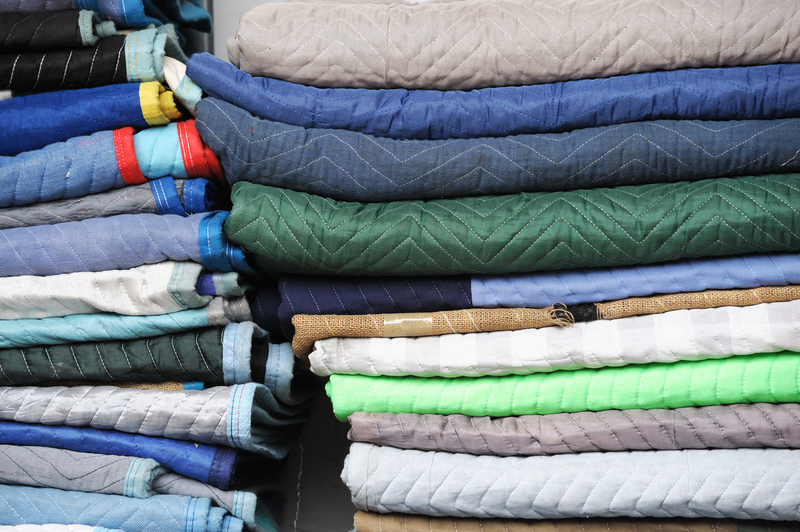The Art of Packing: How to Transition to Your New Home Gracefully
Posted on 29/05/2025
The Art of Packing: How to Transition to Your New Home Gracefully
Moving to a new residence is both an exciting milestone and a daunting task. Navigating this transition with ease is possible with careful planning and a keen understanding of the art of packing. In this comprehensive guide, we will explore how to transition to your new home gracefully and pack effectively, minimizing stress and maximizing efficiency. Whether you are moving for the first time or are a seasoned mover, these tips will transform your moving experience into an organized and even joyful journey.
Understanding the Importance of Organized Packing
Before delving into practical packing techniques, it is essential to acknowledge why organized packing matters. Proper packing ensures that your belongings arrive safely, reduces the risk of loss or damage, and streamlines both departure and settling in. Packing for a smooth home transition isn't just about putting items in boxes--it's about strategic planning and execution.
Benefits of Mastering the Art of Packing
- Stress Reduction: Systematic packing alleviates last-minute chaos.
- Time Management: Organization streamlines the moving timeline.
- Cost Effectiveness: Minimizes the risk of unnecessary expenses from broken or lost items.
- Smooth Unpacking: Items are easier to locate and set up in your new home.

Steps to Transition to Your New Home Gracefully
1. Start Early: Preparation is Key
The process of packing for moving homes should begin weeks before your move date. Procrastination leads to rushed decisions, overlooked items, and increased stress. Create a timeline:
- 6-8 Weeks Before Move: Begin decluttering and making an inventory of your belongings.
- 4 Weeks Before Move: Gather packing supplies such as boxes, bubble wrap, and packing tape.
- 2 Weeks Before Move: Pack non-essential items and plan logistics.
- Final Week: Pack essentials and prepare your "first night" kit.
2. Declutter: Lighten Your Load
One of the cornerstones of graceful home transitions is decluttering. Sort through each room and use the four-box method: keep, donate, sell, or discard. This not only simplifies the packing process but also allows you to start fresh in your new home.
- Keep: Items you use regularly or have sentimental value.
- Donate: Clothes, appliances, and goods in good condition.
- Sell: Valuables you no longer need but others might.
- Discard: Broken or irreparable items.
Decluttering also saves money, as you may need fewer moving boxes and potentially a smaller moving truck.
3. Inventory Management: Track Your Belongings
Use a spreadsheet or moving app to create an inventory of everything you're taking. This step is vital for keeping track of valuables and minimizing loss during the transition to your new home.
- Assign numbers to boxes and log their contents.
- Photograph valuables for insurance and reference.
- Keep important documents, jewelry, and essentials separate for easy access.
4. Gather & Choose the Right Packing Supplies
Stock up on various sizes of sturdy boxes, quality packing tape, bubble wrap, plastic wrap, packing paper, and markers.
Choose specialty boxes for items such as mirrors, glassware, televisions, and artwork to protect belongings during the move.
- Wardrobe boxes for clothing.
- Dish packs for plates and glassware.
- File boxes for important papers.
The Packing Process: Tried & True Techniques
Pack by Room - Stay Organized
Pack one room at a time and label each box clearly with its contents and destination room in the new home. This method is crucial for an orderly moving and unpacking process.
- Label two sides and the top of each box.
- Color coding by room can further streamline organization.
- List contents for quick retrieval on moving day.
Protect Fragile Items: Safety First
When packing fragile items, use plenty of cushioning material to prevent breakage. Wrap each item individually and fill empty spaces in boxes to avoid shifting.
- Use bubble wrap or packing paper for dishes, glasses, and electronics.
- Stack plates vertically as they are less likely to break under pressure.
- Mark boxes as "Fragile" on all sides.
Maximize Space Without Overfilling
Over packed boxes can break, while under packed boxes can collapse. Spread out heavy items to avoid back injuries and keep boxes under 50 pounds each when possible. Fill empty gaps with towels, clothing, or soft items to create stability.
Pack a "First Night" Kit
Your first night in your new home will be far more comfortable with a dedicated box or bag containing essentials:
- Toiletries (toothbrush, toothpaste, soap, shampoo)
- Change of clothes and sleepwear
- Chargers for electronics
- Snacks, bottled water, and coffee supplies
- Bedding and a towel per person
- Medications and important documents
Packing for a graceful transition means thinking ahead to your needs in those first hours and days.
Special Packing Tips for a Smooth Transition
Pack Seasonal Items First
If you're moving to a new home during a specific season, pack off-season clothing, sports equipment, and decorations first. This reduces disruption to your daily routine and makes packing feel more manageable.
Disassemble Large Furniture Properly
Take apart beds, desks, or any large furniture pieces before moving day. Store screws and bolts in clearly labeled zip-lock bags and tape them to the furniture so nothing is lost. This reduces scratches and speeds up reassembly in your new home.
Smart Packing for Electronics
Save the original boxes for TVs, computers, and small appliances, as they offer the best protection. Use cable ties to keep cords untangled, and photograph how everything is connected for easy reinstallation.
Utilize Suitcases and Tote Bags
Maximize capacity by packing heavier household items like books in suitcases with wheels. Cloth shopping bags and gym duffels also make convenient containers for odd-shaped items or last-minute necessities.
Moving Day: Making the Transition Graceful
Work With the Right Movers or Team
If hiring professional movers, research reviews and verify credentials well in advance. For DIY moves, assemble a reliable team of friends or family. Assign tasks, keep everyone hydrated, and communicate clearly for an efficient process.
Keep Essentials Close
Carry valuables, important documents, and prescription medications with you instead of loading them in the moving truck. This ensures accessibility and peace of mind.
Inspect Your New Home in Advance
If possible, visit your new home before move-in day to inspect cleanliness, check utilities, and take measurements. This allows you to solve any issues before the truck arrives and to plan furniture placement efficiently.
After the Move: Settling In With Ease
Unpack Methodically, One Room at a Time
Graceful transition to a new home continues after you arrive. Start with the kitchen and bedrooms, aiming to set up essential areas first before moving on to less urgent rooms.
- Arrange furniture and large items before unpacking boxes.
- Prioritize unpacking essentials - bathroom, kitchen, and bed linens.
- Don't rush; take breaks to avoid fatigue and burnout.
Organize As You Unpack
The best time to organize shelves, drawers, and closets is while unpacking. Take the opportunity to start fresh and be intentional about item placement.
Update Your Address & Utilities
Ensure your mail, subscriptions, and services are transferred or updated before you move in. Notify banks, credit card companies, and government agencies. Arrange for electricity, water, and internet connections ahead of time to guarantee a smooth transition.
Personalize & Enjoy Your New Space
Unpack treasured photos or decor early to quickly make your new house feel like home. Walk your neighborhood, introduce yourself to neighbors, and celebrate your accomplishment!

Frequently Asked Questions on Packing and Moving Gracefully
What is the most efficient way to pack for a move?
- Began early and pack by room and category.
- Use sturdy boxes and ample padding for breakables.
- Label each box clearly for easy identification.
How can I reduce stress during a move?
- Create a moving timeline with milestones and deadlines.
- Enlist help from friends, family, or professionals.
- Focus on one task at a time to avoid feeling overwhelmed.
When should I start packing for my move?
- Begin sorting and packing non-essential items 6-8 weeks in advance.
- Ramp up packing as moving day draws near, saving essentials for last.
Conclusion: Embracing a Seamless Home Transition
The art of packing goes far beyond the act of boxing up your belongings. It is a thoughtful, systematic process that eases stress, safeguards your possessions, and sets the tone for a successful start in your new home. By embracing these packing strategies and transition tips, you can make your move to a new home both efficient and enjoyable.
Remember: Early planning, decluttering, organized packing, and a little patience are the keys to moving gracefully. As you embark on this new chapter, take the time to appreciate the memories you're moving with and the new ones you'll soon create in your new space.



